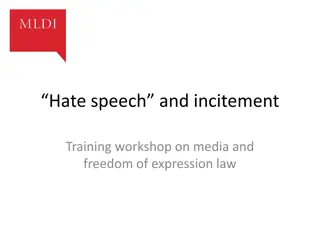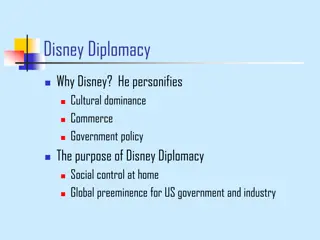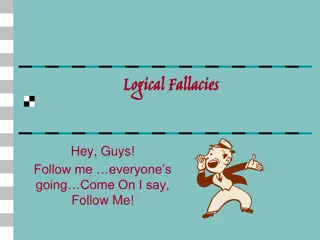Greek coinage in perspective
Explore ancient Greek coinage practices and their modern parallels. Discover attitudes, practices, and the intersection of money with propaganda throughout history.
1 views • 30 slides
Historical Sources as Evidence
Explore the importance of historical sources as evidence in the Victorian Curriculum History context, focusing on how students analyze, evaluate, and utilize sources to create historical explanations and arguments. Discover the significance of primary and secondary sources, perspectives of historica
1 views • 46 slides
Campaign Rhetoric
Rhetoric, the art of persuasive language use, plays a crucial role in political campaigns, focusing on public speaking to sway audience opinions. The ethical implications, such as the use of noble ideas versus dishonest strategies, are also key considerations. Factors affecting persuasiveness includ
0 views • 51 slides
Challenges and Solutions in Implementing Historical Competencies in Teaching
Explore the complexities and obstacles faced in implementing historical competencies in teaching, as discussed by Jens Aage Poulsen, a senior lecturer and researcher at HistoryLab, University College Lillebaelt, Denmark. The content delves into competence-based curriculum, core historical competenci
0 views • 7 slides
Understanding Hate Speech and Incitement in Media and Freedom of Expression Law
This workshop explores the legal implications surrounding hate speech, incitement, and freedom of expression. It delves into the prohibition of propaganda for war, advocacy of hatred, and the balance between state obligations and freedom of speech. Through case law examples like the Jersild case and
1 views • 12 slides
Exploring Symbolism Through Art: Lessons from The Equal Race Mural Project
The presentation outlines "The Equal Race" mural project by Julie Hussey, Alia Oakes, Teagan Tate, and Audrey Thompson, inspired by the Holocaust. It delves into the project's core themes, including hope, despair, and resilience, depicted through a mural featuring a Jewish family, Nazi propaganda, a
1 views • 10 slides
Understanding Mass Media and Advertising in Management Communication N4
Explore the role of mass media and advertising in communication processes, including types of media, functions of mass media, language choices, manipulative reporting, propaganda techniques, advertising principles, and effective advertising requirements. Engage in various activities to enhance learn
3 views • 6 slides
Women's Role in Nazi Germany: Impact and Ideology
Explore how the Nazis shaped the role of women through policies and propaganda, emphasizing domesticity and motherhood. Analyze key figures like Joseph Goebbels and Hitler's perspectives on women's place in society. Understand the contrast between women's lives in Weimar and Nazi Germany.
0 views • 18 slides
The Rise of Hitler: Establishing the Nazi Police State in Germany
This content chronicles the key events leading to Hitler's rise to power in Germany, focusing on the establishment of the Nazi Police State through propaganda, surveillance, and punishment. It discusses Hitler's use of violence, propaganda, and speeches to solidify his control. The effectiveness and
0 views • 9 slides
Understanding Dystopian Societies in 1984 Novel Guide
Explore the themes of utopia and dystopia in George Orwell's 1984 novel through a comprehensive guide. Learn about the characteristics of dystopian societies, types of controls, and the role of protagonists in challenging oppressive systems. Dive into the discussions on propaganda, surveillance, deh
0 views • 10 slides
Retrieval Practice in Animal Farm: Lessons on Communism, Allegories, and Propaganda
In this detailed study guide, explore key themes from George Orwell's "Animal Farm", focusing on topics like the Communist Manifesto, bourgeoisie representation, capitalism vs. communism, rhetorical strategies, Karl Marx, fables, anthropomorphism, allegories, Russian Revolution parallels, and the us
1 views • 20 slides
Exploring the Politics and Ideals in Virgil's Aeneid
Delve into the complexities of divine intervention, Roman values, and Augustan heroism in Virgil's Aeneid. Unravel the intricate relationship between politics, epic form, and the subversive readings of this classical work. Challenge traditional interpretations and ponder the nuanced interplay of pro
0 views • 11 slides
Understanding Wartime Propaganda in WWI
Wartime propaganda during WWI was employed for various purposes such as recruiting soldiers, financing the war effort, and unifying the country. It used tools like demonization, emotional appeals, patriotic appeals, and half-truths to sway public opinion and support the war. An in-depth analysis of
0 views • 7 slides
The Ruthless Reign of Joseph Stalin in the Soviet Union
Joseph Stalin rose to power in the USSR after Lenin's death, implementing totalitarian control through purges, collectivization, and propaganda. His regime led to millions of deaths, forced labor camps, and a cult of personality, shaping Soviet society through fear and oppression.
0 views • 8 slides
The Cold War: Rivalry and Tension Between Superpowers
The Cold War, lasting from post-World War II to the 1980s, was defined by political tension and rivalry between the United States and the Soviet Union. Despite never engaging in direct military combat, both sides competed through political maneuvering and propaganda, impacting global conflicts and t
0 views • 11 slides
Understanding the Different Types of Misinformation and Fake News
Explore the various forms of misinformation such as fake news, satire, fabrication, manipulation, propaganda, and dissemination. Learn how fake news impacts public perception and how it can mislead individuals. Discover the prevalence of fake news and its effects on society.
2 views • 11 slides
The Rise of Hitler and the Changes in the Nazi Party 1920-1922
Explore how Adolf Hitler ascended to power and examine the significant developments within the Nazi Party between 1920 and 1922, including Hitler's role, the creation of the SA, the 25 Point Programme, Hitler's leadership, and the use of propaganda and violence.
0 views • 13 slides
Disney Diplomacy: Cultural Influence and Political Objectives
Disney's role in diplomacy, particularly in South America, reveals a complex interplay between cultural dominance, commercial interests, and government policies. The Good Neighbors Office aimed to counter German propaganda through positive American portrayal, but overlooked cultural differences and
4 views • 8 slides
The Transition from Rural Community to Urban Mass Society: Impact of Media Technologies
Our lives are influenced by the saturation of media technologies and images, leading to questions on American culture and politics. The shift from rural community to urban mass society has resulted in individuals being isolated and disconnected from traditions and values, shaping their hearts and mi
0 views • 16 slides
Covert Actions and Their Consequences
The chapter discusses foreign covert actions, their limited statutory control, and the President's discretion in carrying them out. It delves into the Bay of Pigs incident, forms of covert actions like propaganda and paramilitary actions, unintended consequences, and the Neutrality Act of 1794. The
1 views • 31 slides
Understanding Logical Fallacies and Persuasion Techniques
Learn about logical fallacies, persuasive writing, propaganda, and types of fallacies with examples like circular reasoning and false causality. Recognize how persuasive texts aim to influence readers and the importance of critical thinking when encountering different argumentative strategies.
0 views • 31 slides
Exploring "Brave New World": An Introduction to Dystopian Satire
This guide provides an overview of Aldous Huxley's "Brave New World," discussing its themes of propaganda, censorship, conformity, genetic engineering, and social conditioning. Delve into the novel's depiction of a controlled society, the use of technology, consumerism, and the satire employed to cr
1 views • 15 slides
Understanding Propaganda Techniques
Explore different propaganda techniques such as Name-Calling, Bandwagon, Red Herring, Emotional Appeal, Testimonial, Repetition, Sweeping Generalization, and Circular Argument. These techniques manipulate people's emotions and perceptions to influence their decisions. Be vigilant against these strat
0 views • 26 slides
The Cold War Rivalry: 1950s-1960s Espionage and Arms Race
The period from the 1950s to the 1960s was marked by intense competition between the Soviet Union and the US in the realms of espionage, space exploration, and nuclear armament. The Cold War rivalry led to significant advancements in technology and heightened tensions, culminating in key events like
0 views • 7 slides
The Accession of Darius: A Comparative Analysis
Explore the two versions of King Darius's rise to power following Cambyses' death in 522 BC. Compare the accounts from Herodotus and Darius's Bitsitun Inscription, highlighting similarities, differences, and potential propaganda elements. Delve into the intriguing narrative complexities surrounding
0 views • 8 slides
Analyzing Wartime Propaganda Objectives and Techniques
Explore the objectives and tools utilized in wartime propaganda, including recruitment of soldiers, financing war efforts, unifying nations behind a cause, resource conservation, and fostering home-front support. Delve into common techniques like demonization, emotional appeals, name calling, patrio
0 views • 22 slides
Analyzing Bias and Propaganda in Boston Tea Party History
Explore the Boston Tea Party through language and imagery, learning to examine information from multiple perspectives and detect bias and propaganda. Engage with visual materials, such as political cartoons, and texts like the 1773 Massachusetts Gazette article to determine if they were created by p
0 views • 10 slides
Understanding the Mechanisms of Propaganda Through Historical Examples
Explore the workings of propaganda through historical artifacts from World War I, showcasing how nations used persuasive messaging to influence public opinion, rally support for war efforts, and shape cultural narratives. Images of propaganda posters and war bonds illustrate the powerful impact of v
0 views • 24 slides
World War I Test Review and Historical Overview
Learn about the key terms and concepts related to World War I, including militarism, nationalism, neutrality, propaganda, espionage, and more. Explore the long-term causes of the war, the immediate trigger, the Central Powers and Allied Powers involved, as well as important events like the Zimmerman
0 views • 13 slides
The Evolution of Propaganda: From the 1600s to Hitler's Regime
The term "propaganda" originated in the 1600s without a negative connotation until World War I when it became a tool of persuasion and manipulation. Countries utilized propaganda extensively during WWI to sway public opinion. The United States established a propaganda bureau, while Nazi Germany saw
0 views • 32 slides
Education for Peace: A Call to Prioritize Socio-Educational Changes
Communist regime propaganda has sidelined the importance of educating about peace in public discourse. The concept of peace encompasses the absence of war, violence, and the promotion of tolerance. Defining education for peace entails shaping attitudes towards living harmoniously with oneself, other
0 views • 12 slides
Lessons from Rwanda: Hatred, Propaganda, and War
Explore the dark era of the Rwandan Genocide, delving into the themes of hatred, propaganda, and warfare. Learn about the use of propaganda in influencing people and its impact during the conflict. Follow the timeline of events leading up to the genocide and the efforts for ceasefire amid escalating
0 views • 5 slides
Understanding Propaganda: Definition, Examples, and Impact
Propaganda is a form of communication that aims to influence the attitudes of a population towards a cause or position. It can be used to manipulate information selectively, evoke emotional responses, and shape perceptions. This article explores the definition of propaganda, its historical context,
0 views • 17 slides
Understanding Maoist Propaganda Through OPTIC Analysis
Explore the use of OPTIC analysis to dissect Maoist propaganda posters from the Chinese Cultural Revolution. Uncover the hidden messages and visual rhetoric employed by the government to influence perceptions and promote certain ideologies.
0 views • 25 slides
The Battle of the Cowshed: Fictional vs. Historical Conflict
A portrayal of The Battle of the Cowshed, where humans clash with animals in a fictional historical conflict. The animals emerge victorious, led by Snowball. This narrative intertwines the fictional and historical aspects of the Russian Civil War, illustrating propaganda warfare and final victory.
0 views • 10 slides
Understanding Political Spin and Propaganda in Media
Explore the tactics of political spin and propaganda as tools used to shape public perception and manipulate information. Learn about the techniques politicians employ to navigate media dynamics and the covert spin tactics employed in the realm of communication and journalism.
0 views • 10 slides
Developing Historical Thinking Skills in AP World History
AP History classes aim to cultivate apprentice historians by fostering historical thinking skills (HTS). These skills include Chronological Reasoning, Comparison and Contextualization, Crafting Historical Arguments, and Historical Interpretation. Each skill set equips students with the ability to an
0 views • 15 slides
Prohibition and Legalization: Lessons for Policy Change
Explore the journey from prohibition to legalization in the context of economics and policy change, delving into the impact of ideology, success of different policies, and the historical background of prohibition on narcotics, alcohol, and cannabis. Discover how prohibition has been influenced by ig
0 views • 11 slides
Types of Propaganda Techniques in Animal Farm by George Orwell
Explore different propaganda techniques illustrated in George Orwell's novel, Animal Farm, including bandwagon, testimonial, repetition/hypnotism, plain folks, ego building/snob appeal, emotional words/patriotic slogan, and value/durability. Learn how these techniques manipulate perceptions and shap
1 views • 12 slides
Overview of Nazi Propaganda and Control Methods
The content discusses different types of Nazi propaganda, the reasons behind Kristallnacht, and the effectiveness of terror as a control method by the Nazis. It highlights how propaganda, violence, and fear were utilized to manipulate and suppress the German population during the Nazi regime.
0 views • 8 slides







































